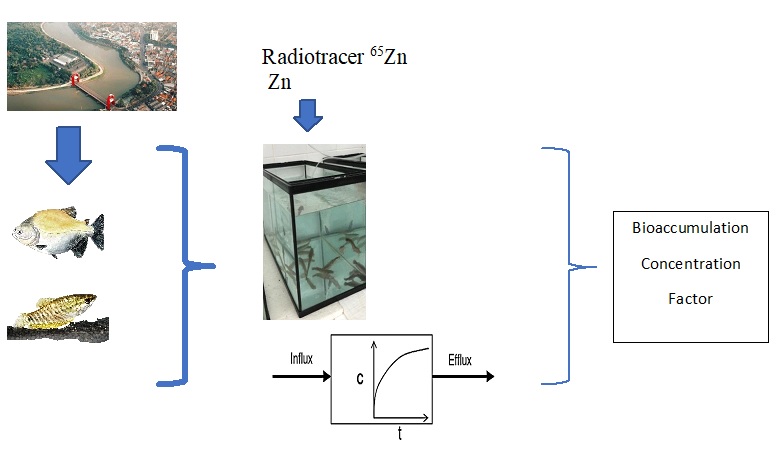The Effect of Zinc Speciation and Its Concentration on Bioaccumulation in Pomfret (Colossoma macropomum) and Sepat Fish (Trichogaster Trichopterus)
DOI:
https://doi.org/10.48048/tis.2023.4047Keywords:
Bioaccumulation, Biokinetics, Pomfret, Sepat fish, ZincAbstract
Heavy metal Zinc is still a pollutant from various industrial and domestic activities whose waste is directly dumped into the waters. The presence of biota in the waters can be used as a bioindicator to identify the presence of heavy metal contaminants. The kinetics of the Zinc bioaccumulation process through the freshwater route using pomfret (Colossoma macropomum) and sepat fish (Trichogaster trichopterus) as bioindicators have been investigated by analyzing the effect on variations in concentration and pH. This research was conducted by determining Zinc speciation's effect and concentration on the bioaccumulation process. The results showed an increase in concentration would also increase the rate of uptake and elimination rate of Zinc by pomfret and sepat, obtained concentration factors (CF) at variations of Zinc concentration in pomfret was 2.56 - 22.97 mL.g–1 and 2.14 - 56.87 mL.g–1 in sepat fish. While the value of the concentration factor (CF) in the variation of pH for pomfret is 0.65 - 13.15 mL.g–1 and for sepat fish is 0.93 - 15.29 mL.g–1, and ZnCl42– was the dominant species containing Zn in most of the electrolytes in fresh water and from each concentration variation. This method is expected to provide information that can be used for environmental studies and against toxic effects for food safety.
HIGHLIGHTS
- The kinetics of the Zinc bioaccumulation process through the freshwater route as bioindicators have been investigated
- This research was conducted by determining Zinc speciation's effect and concentration on the bioaccumulation process
- Provides information on the accumulation of Zinc in Pomfret ( macropumum) and Sepat Fish (T. trichopterus) to be used as an environmental study and for food safety purposes
GRAPHICAL ABSTRACT
Downloads
Metrics
References
MS Islam, MB Hossain, A Matin and MSI Sarker. Assessment of heavy metal pollution, distribution and source apportionment in the sediment from Feni River estuary, Bangladesh. Chemosphere 2018; 202, 25-32.
S Xu and S Tao. Coregionalization analysis of heavy metals in the surface soil of inner Mongolia. Sci. Total Environ. 2014; 320, 73-87.
JD Allison and TL Allison. Partition coefficients for metals in surface water, soil, and waste. U.S. Environmental Protection Agency, Washington DC, 2005.
S Hou, N Zheng, L Tang, X Ji, Y Li and X Hua. Pollution characteristics, sources, and health risk assessment of human exposure to Cu, Zn, Cd, and Pb pollution in urban street dust across China between 2009 and 2018. 2019; 128, 430-7.
MMN Authman, MS Zaki, EA Khallaf and H Abbas. Use of fish as bioindicator of the effect of heavy metals pollution. J. Aquac. Res. Dev. 2015; 6, 1-13.
G Leblanc. Basic of environmental toxicology. John Wiley and Sons, Inc., New Jersey, 2014, p. 640.
H Suseno, S Hudiyono, B Budiawan and DS Wisnubroto. Effects of concentration, body size, and food type on the bioaccumulation of hg in farmed tilapia Oreochromis mossambicus. Aust. J. Basic Appl. Sci. 2010; 4, 792-9.
PS Rainbow and SN Louma. Metal toxicity, uptake and bioaccumulation in aquatic invertebrates-modelling Zinc in crustaceans. Aquat. Toxicol. 2011; 105, 455-65.
H Suseno and SM Panggabean. Merkuri: Speasiasi dan bioakumulasi pada biota laut. J. Waste Manag. 2007; 10, 66-78.
SW Fowler, B Danis, JL Teyssie and O Cotret. Applied radiotracer techniques for studying pollutant bioacumulation in selected marine organisms (jellyfish, crabs, and sea stars). Nukleonika 2004; 49, 97-100.
ND Takarina, AIS Purwiyanto and Y Suteja. Cadmium (Cd), copper (Cu), and zinc (Zn) levels in commercial and non-commercial fishes in the Blanakan River Estuary, Indonesia: A preliminary study. Mar. Pollut. Bull. 2021; 170, 1-9.
LL Mapenzi, MJ Shimba, EA Moto, RS Maghembe and AJ Mmochi. Heavy metals bioaccumulation in tilapia and catfish species in Lake Rukwa Ecosystem Tanzania. J. Geochem. Explor. 2020; 208, 1-6.
E Has-Schon, I Bogut, R Vuković, D Galović, A Bogut and J Horvatić. Distribution and age-related bioaccumulation of lead (Pb), mercury (Hg), cadmium (Cd), and arsenic (As) in tissues of common carp (Cyprinus carpio) and European catfish (Sylurus glanis) from the Buško Blato Reservoir (Bosnia and Herzegovina). Chemosphere 2015; 135, 289-96.
H Ali, E Khan and I Ilahi. Environmental chemistry and ecotoxicology of hazardous heavy metals: Environmental persistence, toxicity and bioaccumulation. Hindawi J. Chem. 2019; 2019, 1-15.
D Shi and WX Wang. Understanding the differences in Cd and Zn bioaccumulation and subcellular storage among different populations of marine Clams. Environ. Sci. Technol. 2004; 38, 449-56.
FJ Millero, RJ Woosley, B Ditrolio and W Jason. Effect of ocean acidification on the speciation of metals in seawater. Oceanography 2009; 22, 72-85.
B Budiawan, H Suseno, F Afriani and WR Prihatiningsih. Bioaccumulation and retention kinetics of trace elements in the horse mussels modiolus micropterus exposed to different environmental conditions. Environ. Toxicol. Pharmacol. 2021: 87, 1-7.
Y Lin, X Wang, B Wang and OAA Mohamad. Bioaccumulation characterization of Zinc and cadmium by Streptomyces zinciresistens, a novel actinomycete. Ecotoxicol. Environ. Saf. 2012; 77, 7-17.

Downloads
Published
How to Cite
Issue
Section
License
Copyright (c) 2022 Walailak University

This work is licensed under a Creative Commons Attribution-NonCommercial-NoDerivatives 4.0 International License.






